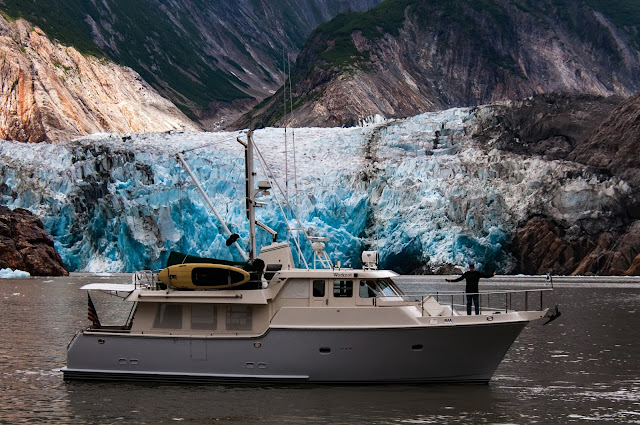Traveling to this stunning location included Stephens Passage as we left
Petersburg Alaska. We only stayed one
night in this hardy fishing town. Known
as the Halibut capital of Alaska we found the docks and the small town
friendly. Landing at Petersburg was a
flashback to a tough landing at La Paz Mexico over a year ago where the current
swept WORKNOT to the dock broadside.
This time experience won out and on the second attempt made a fairly
good landing in 3-4 kts of cross current.
The harbor actually had an eddy current going opposite of the arrival
current. No battle scars this
time.
Petersburg is very proud of its Norwegian heritage and the
Sons of Norway museum was having some type of show when we arrived. A school bus load of folks a little older
than us were greeted by young girls in full costume as they arrived. Sorry, we did not have a phone or camera
available to get more pictures. I can
just imagine Sig from “Deadliest Catch”
strolling the streets of Petersburg.
The current was on our side as we headed north giving us
about 1-2 kts of push almost the entire way to Hoolkham Bay. Our original plan was to make this trip in
two nights but the added speed got us into Tracy Arm Cove just before dinner. Rain and fog were with us all day but never
totally blocking visibility or slowing our pace.
Entering Holkham Bay requires crossing a bar that shallows
from over 300' to just over 40’. The
opening is 1.75 miles wide but navigable at a width of only 0.3 miles. The channel is marked by two buoys with a
note indicating one of them is often carried off its location by icebergs.
We anchored in Tracy Arm Cove with several other boats, one
asked us to move after we had set our anchor-announcing he was 100 ft long and
needed more room, and settled in for a quiet evening as the rain had ended and
the air was very calm. About midnight
winds picked up and by 1 AM wind was blowing 20-30 kts in sharp gusts. This is known as a Williwaw wind and it is
caused by cold air rushing down the face of the glacier and mountains. Localized but strong they can reach over 50
kts in some areas. Added about 75 ft of scope to our anchor and
slept in the pilot house to be ready if we moved. By 3 AM winds had calmed down and WORKNOT was
still firmly attached to the bottom by our dependable Rocna anchor. (If you want to start a dock argument; just ask any boater which is the best
anchor).
A few of our neighbors at Tracy Arm Cove.
Our friends on Antipodes led the way during the 22 mile trip
up Tracy Arm to see the glacier. We saw
some ice early on but things were fairly clear until we got about 4 miles from
the split where Tracy Arm branches into the North and South arms leading to the
face of the Sawyer Glacier.
Along the way stunning water falls on both sides of the fjord
provide enough water that the normal current flow is always and ebb.
Fog and mist hung low in the air but our trip was not
hampered by the low ceiling. Running in
the ice flow with heavy fog would not be possible and we kept a close watch
behind us to be sure we did not get closed in.
Several tour boats from Juneau raced ahead of us to the face
of the glacier. Following Antipodes
(Steel Hull) took plenty of effort and several times had to push “bergy bits”
off the bow to make a path. Even the
small pieces of ice made a terrible sound against the hull.
The color and shape of the bergs was mesmerizing. Blue tones and exotic shapes drew your
attention from piloting the boat to staring at them in wonderment.
Finally we made our way to the face of the glacier. Caught a calving of pieces about the size of
the boat but too slow with the camera.
The granite face of the fiord walls is rubbed smooth and
towers up to 2,500 ft above us. Loss of
VHF, GPS and satellite communications is normal in some of the areas. According to the charts the glacier has
retreated over half a mile since 1995.
Just 20 years ago the spot we were floating in was on the face of the
glacier. The dashed area was glacier when the chart was drawn...
As you can see we had a very spectacular day. A few more pictures to better express what we
got to see.
Simply amazed........
Keela came to help, in spirit, as I pushed ice away from
WORKNOT
Box Score 10 Hours, 40 miles, 21 gallons (VERY slow moving
in the ice field)
Many thanks to Randy, Nancy and Adam on Antipodes for the pictures of WORKNOT...



















No comments:
Post a Comment